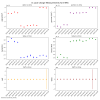Rick, Keita, Sheila, Daniel, remote help from Matt Heintze
This morning we swapped the NPRO laser controller S2200009 out for S2200008.
Settings before we started: Laser diode A set temperature 18.3C, Laser diode B set temperature 15.99C, laser diode injection current 2.134 Amps, laser crystal set temperature 26.04 C, laser crystal actual temperature 26.10 C.
We went to the diode room, and followed the notes from the procedure Ryan Short outlined to me to shut down the amplifiers, turning off amp2, then amp1, then closing the shutter, then we went one step beyond his instructions and shut off the NPRO. We swapped the controller with all the cables, including the interlock.
When we powered on S2200008 laser diode A temperature was set to 17.14, B set to 22.96C. We adjusted the pots on the front panel until they matched the values we had written down from the original controller. We turned the knob on the front panel for the injection current to 0. Rick and I went to the laser diode room and turned the NPRO back on, Keita confirmed that this turned on the controller. We noticed that the laser diode 1 and 2 set temps were what we had set them to be by adjusting the pots for A and B, but the act temp readbacks weren't matching, we confirmed with photos that with the original controller the set and actual temps matched. (I will attach a photo of this state). At the rack Ketia turned the injection current up to about 100mA, this didn't change the temperature readbacks.
We had a discussion with Matt Heinze, who agreed this is probably a readback issue and that it was safe to keep going. We think that this is because we haven't adjusted the pots on the LIGO daughter board following T1900456. Keita slowly turned up the injection current knob while Rick and I watched from the diode room, the NPRO power came back to 1.8W which was the same as before. The laser diode act power readbacks for diode 1 says 3.6W, while it was 5W with the original controller, and diode 2 says 2.48W where it also said 5W with the original controller. Since the power output is the same, we think these are also just readback problems due to not following T1900456. We opened the shutter, turned on the amplifiers after a few minutes, and set the power watchdogs back on, as well as the pump diode watchdog.
The PMC and FSS locked without issue, Daniel found that the squeezer laser frequency had to increase by 850MHz to get the squeezer TTFSS locked, so we moved the NPRO temperature up on the FSS by about 0.3 K. After this the squeezer and ALS lasers locked easily, and Oli relocked the IFO.
The first attached photo is the NPRO screen on the beckhoff machine before the controller swap, the second photo is after.
While Oli was relocking we saw that there are still glitches, both of the attached screenshots were taken while the IFO was in the engage ASC state.
Seeing this and based on Camilla's observation that the locklosses started 80561 on the same day that we redistributed gains to increase range in the IMC servo board in 79998, we decided to revert the change, which was intended to help us ride out earth quakes. Daniel points out that this makes some sense, that it might help to ride out the earthquake if we limit the range available to the carm servo. We hope that this will help us to ride out the glitches better without loosing lock.
Rick went back to the diode room and reset the watchdogs after the laser had been running for about 2 hours.











































